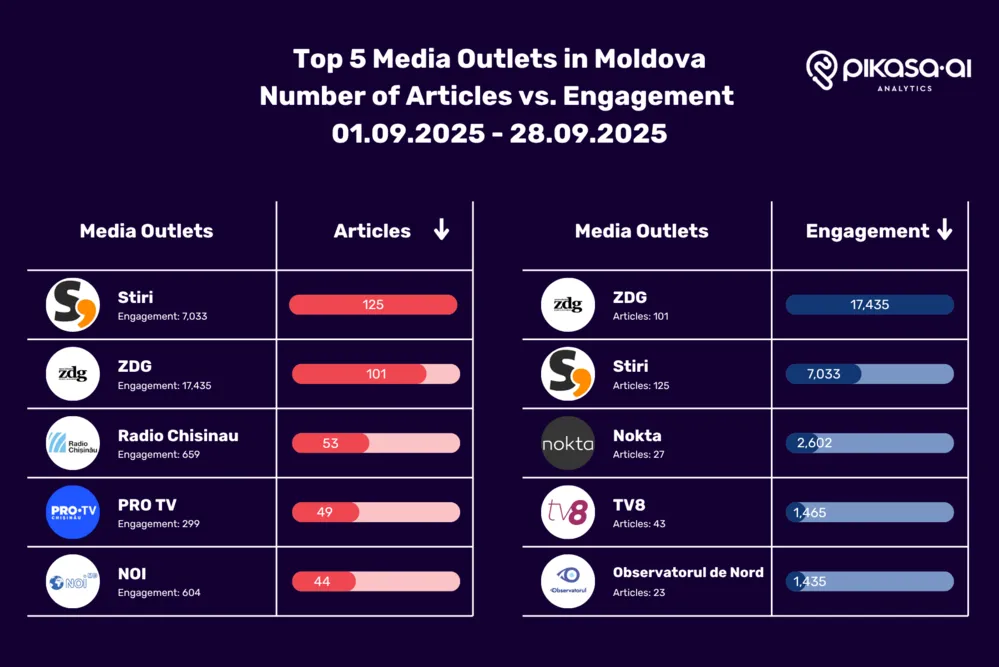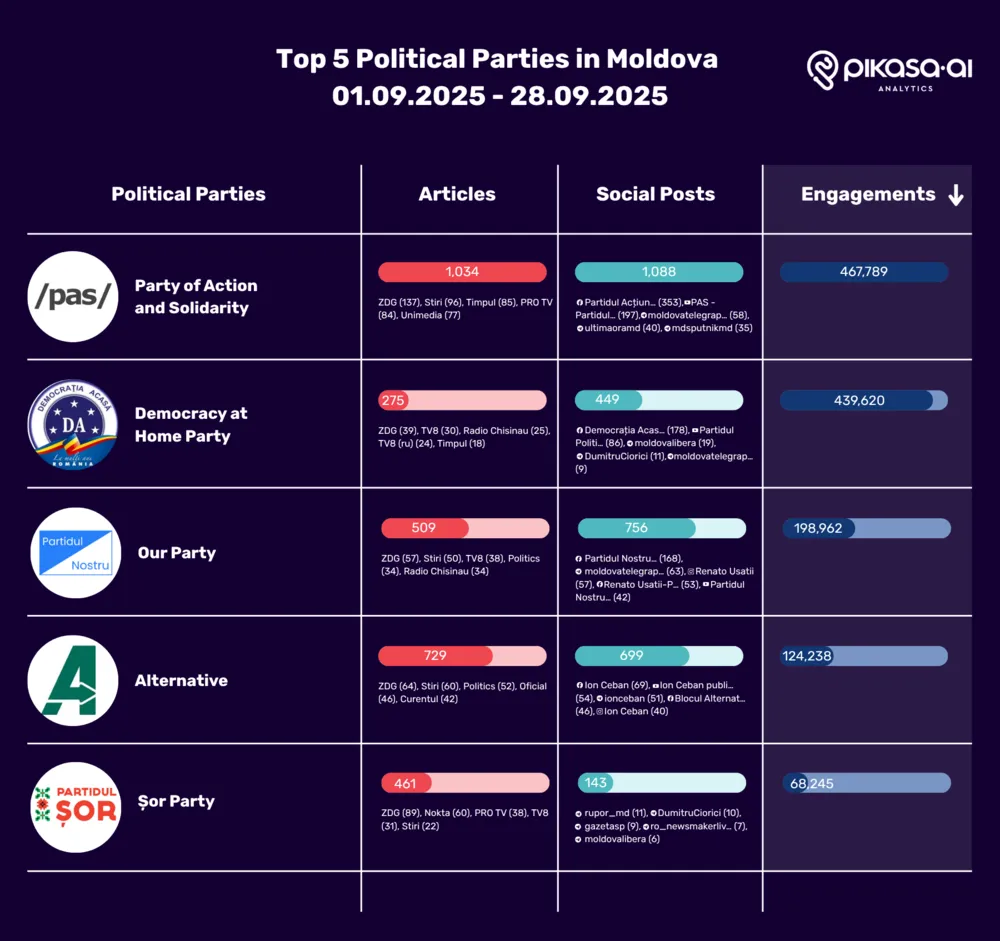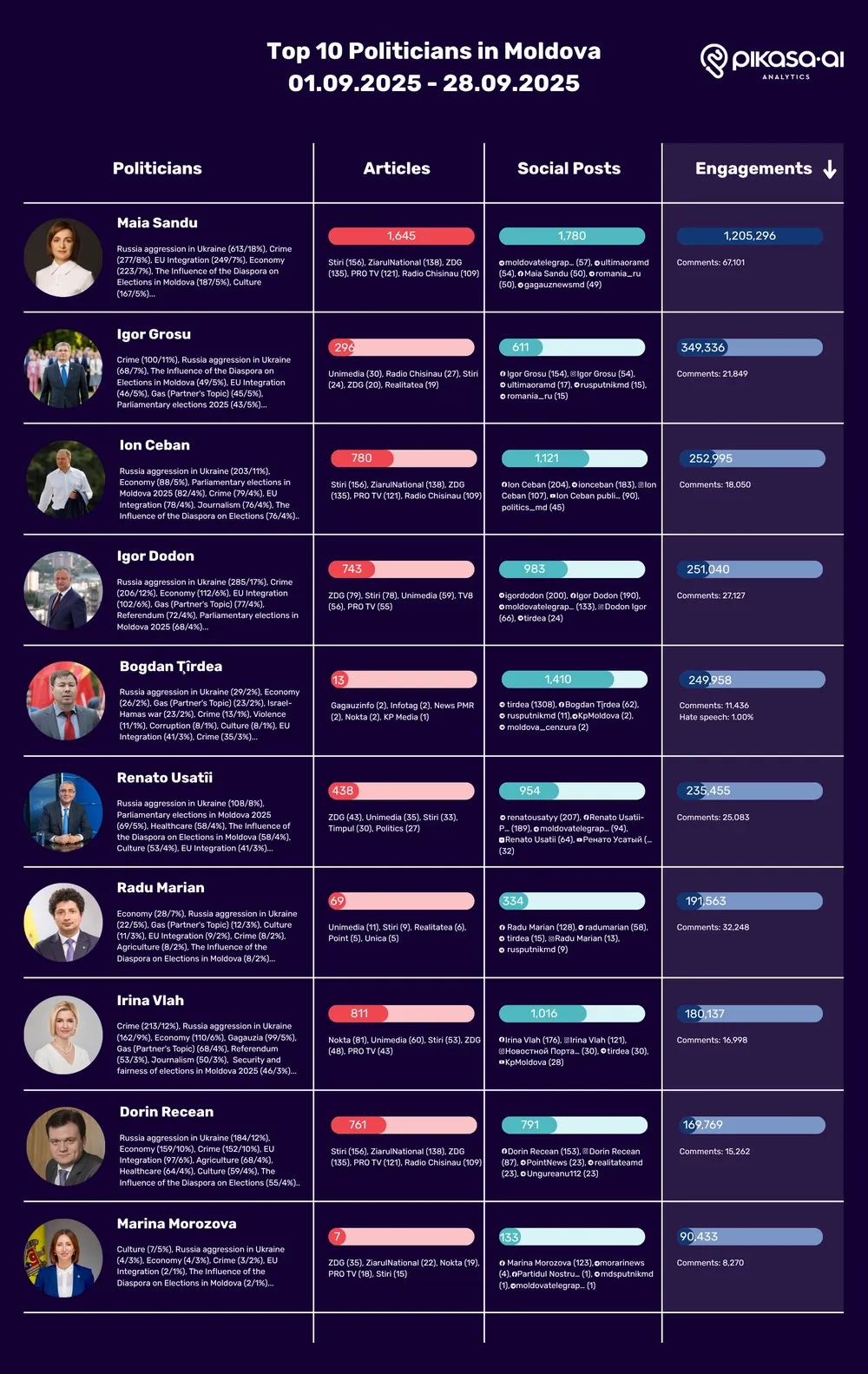Who Won the Ballot, Who Won the Buzz? Moldova’s 2025 Elections
The 2025 parliamentary elections in Moldova revealed how political outcomes and digital narratives are inseparable. Using the Pikasa Analytics platform - Analytics.Live, this case study combines official results with media coverage analytics, audience engagement tracking, and social media influence elections data to show how the pro-European PAS Moldova victory was shaped by both ballots and online conversations. From diaspora voting Moldova to shifts in sentiment across platforms, the findings demonstrate the value of AI-powered media analysis and real-time media monitoring tools in understanding modern elections and political communication.
On 28 September 2025, Moldovans went to the polls in an election framed as a battle over the country’s geopolitical future. The outcome delivered a decisive victory for the pro-European Party of Action and Solidarity (PAS), but the story of this election extends far beyond the ballot box. Media coverage, social platforms, and diaspora mobilization shaped the narrative as much as official speeches or party manifestos. This case study combines official results with digital engagement data to explore how politics and media intertwined in Moldova’s most consequential election in a decade.
At the Crossroads of Europe: Moldova’s 2025 Vote
The Republic of Moldova held parliamentary elections on 28 September 2025. The vote was widely seen as a choice between continuing a Pro European Union (EU) course and pivoting back toward closer ties with Russia. Fears of Russian interference, cyberattacks and misinformation campaigns were widespread during the campaign. Moldova’s parliament has 101 seats, so any party or coalition needs at least 51 seats to form a majority.
Winners and Losers at the Ballot Box
Preliminary results published by Moldova’s Central Electoral Commission and reported by RFI and Balkan Insight show that five political blocs crossed the 5% electoral threshold and won seats in parliament. The turnout was 52.20%. And with 99.9% of ballots counted PAS continues to control the legislature (55 out of 101 seats) and is positioned to maintain Moldova’s EU integration agenda. The Pro Russian BEP remains the largest opposition force (26 out of 101) but lacks the numbers to block reforms. Alternativa (8 out of 101) Democracy at Home (6 seats) and Our Party (6 seats) gained parliamentary representation, illustrating a diversification of the political landscape.
Clicks, Shares, and Comments: Mapping the Digital Pulse
The election campaign generated unprecedented online discussion. The analytics platform Analytics.Live tracked articles, social media posts and reader engagement for topics related to the elections. Between 1 September and 28 September 2025, the platform logged 13462 articles and 17047 social posts about political parties, producing 5.474.816 total engagements (likes, shares and comments). Engagement surged in the final days of the campaign and spiked on 28 September, the day of the voting.
Elections in the focus
The graphic below plots daily article counts for “Parliamentary elections in Moldova 2025.” Coverage of the general election (blue) remained steady at 10 - 30 articles per day until it jumped dramatically on 28 September, reflecting heightened interest as results were released.

The general statistics table from analytics.live shows that the main election topic generated 710 articles, 38,496 engagements, an average of 54 engagements per article, and coverage across 42 media outlets.
In Moldova’s media landscape during 01.09.2025 - 28.09.2025, Stiri published the highest number of articles (125), while ZDG achieved the strongest audience impact, driving over 17,000 engagements despite producing fewer articles (101). Other outlets showed contrasting patterns: Radio Chisinau, PRO TV, and NOI ranked among the top by article volume but generated modest engagement. On the other hand, Nokta, TV8, and Observatorul de Nord published fewer articles yet managed to secure notable audience interactions, highlighting different strategies in content reach and resonance.

Narratives in Motion: Social Media and Media Dynamics
Analytics.live identified the 50 most engaged articles about the election. Many of the most shared stories came from Stiri, the investigative outlet Ziarul de Gardă (ZDG) and other local media. Key narratives included:
- Maia Sandu’s appeals to voters: Several widely shared pieces featured President Sandu urging unity and courage, framing the election as crucial for Moldova’s future.
- Warnings about Russian interference: Commentators such as Arsen Avetisian and journalist Alexander Nevzorov warned that Russia might exploit the vote, asserting that “Putin will turn Moldova into a bloody path towards Odesa”.
- Diaspora turnout: A live text article chronicled record participation of more than 250 000 diaspora voters, underlining the importance of votes cast abroad.
- Sanctions against proRussian figures: Reporting on authorities blocking the economic resources of proRussia politician Irina Vlah and other sanctionlisted figures drew significant engagement.
- Voting irregularities and appeals to peace: Articles reported on alleged irregularities, appeals for calm and calls for postelection protests by opposition leaders Igor Dodon and Ilan Şor.
Who Dominated Online? Party-Level Trends
Digital coverage varied significantly by political party. The charts below summarize the number of articles, social media posts and estimated engagements captured by analytics.live.

The balance between ballots and digital influence is largely aligned. PAS not only emerged as the overall winner of the vote but also dominated the media and social media landscape, driving the highest volume of coverage and engagement. The Patriotic Electoral Bloc (BEP) secured strong representation in the vote but underperformed online, where heavy reporting did not translate into strong interactions. Alternativa and Our Party managed to enter the new political map with notable visibility, yet their digital traction remained modest. The standout exception was the Democracy at Home Party, which, despite minimal coverage, generated engagement levels that nearly rivaled PAS - proving that while most results at the ballot box reflected digital strength, a targeted online strategy can still punch far above its weight.
Politicians Beyond the Ballot Box
Analytics.live also tracked individual politicians. The ten most mentioned politicians are summarised below. Engagement numbers are approximate and reflect total reactions across articles and social posts.

The politician data highlights how figures associated with both proEuropean and proRussian camps dominated online conversations. President Sandu generated more than one million engagements, far surpassing any other politician. Interestingly, Igor Grosu achieved high engagement relative to the number of articles mentioning him, reflecting the effectiveness of targeted social media campaigns.
Women’s Participation: An Information Spotlight
Legal quotas and candidate lists
Moldova’s electoral law requires that at least 40% of candidates on party lists be women. A UNDP supported study by the Center Partnership for Development found that women made up 44.5% of candidates in the 2025 elections, nearly achieving parity. However, the share of female candidates slightly declined compared with 2021, and their placement on lists was uneven. Women comprised 40.7% of candidates in the first ten positions but 42% in positions 11 - 20. Men still dominated the top positions, while women were more concentrated in lower quintiles, reducing their chances of being elected. Some parties merely complied with the quota, whereas others exceeded it and placed over 50% women on their lists.
The Road Ahead for Moldova
The 2025 Moldovan parliamentary elections reaffirmed the dominance of the proEuropean PAS, which secured just over half of all votes and retained a parliamentary majority. The Patriotic Electoral Bloc remained the principal opposition but could not prevent PAS from steering Moldova toward EU integration. Two new blocs, Alternativa and Democracy at Home, entered parliament, suggesting a more pluralistic political landscape.
Beyond the official results, the digital footprint reveals how narratives about the election were shaped. Analytics.live data show that coverage and engagement surged in the final days before the vote, with President Maia Sandu and PAS party dominating online conversations. However, smaller parties such as the Democracy at Home Party achieved disproportionate engagement relative to their coverage, highlighting the power of targeted social media strategies. At the individual level, proEuropean and proRussian politicians alike leveraged online platforms to mobilize supporters, with Sandu generating more than one million engagements.